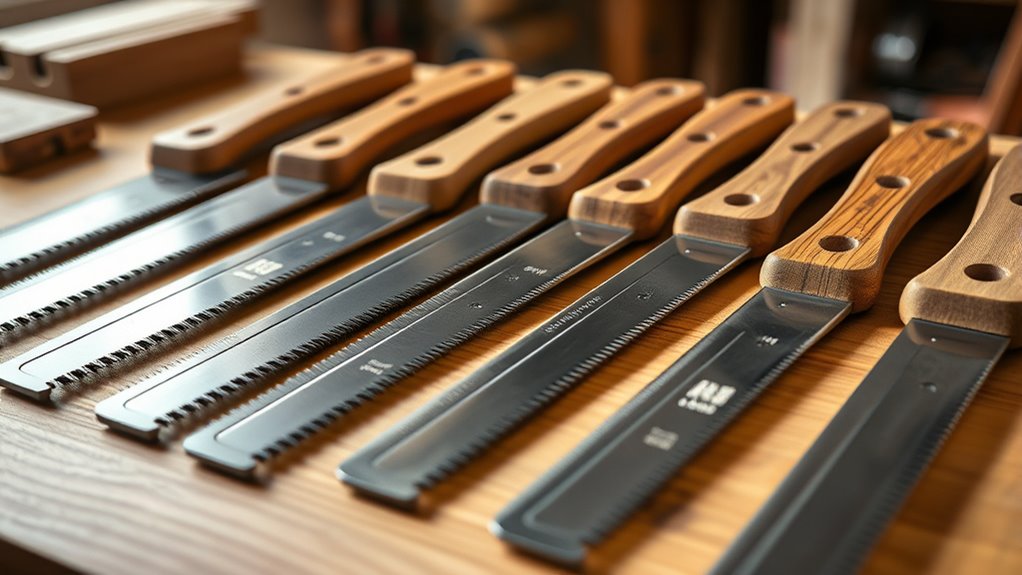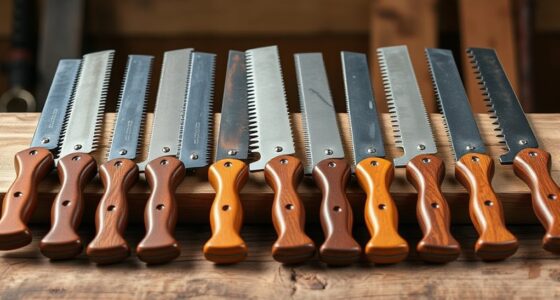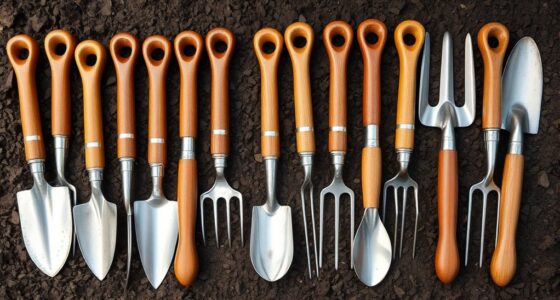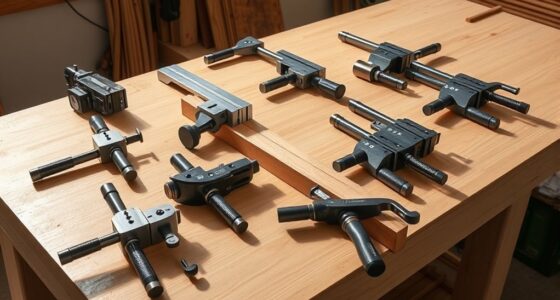If you’re looking for the best Japanese pull saws for precise, effortless cuts, I recommend considering options like the SUIZAN Ryoba, Dozuki, or RUITOOL models. These saws feature high-quality steel blades, dual-function teeth, and ergonomic handles that make woodworking smoother. They’re perfect for detailed joinery, dovetails, and general cuts. Continue with me to discover the top picks, their features, and tips on choosing the right saw for your projects.
Key Takeaways
- Japanese pull saws feature high-quality steel blades designed for clean, precise cuts with minimal effort.
- They come in various sizes and tooth configurations for detailed work, joinery, and general woodworking.
- Crafted with durable materials like SK85 steel, brass fittings, and ergonomic handles for longevity and comfort.
- Their pull stroke mechanism reduces fatigue and provides better control compared to traditional push saws.
- Many are handcrafted in Japan, blending heritage craftsmanship with modern performance for professional results.
SUIZAN Ryoba Double Edge Saw (9.5″)
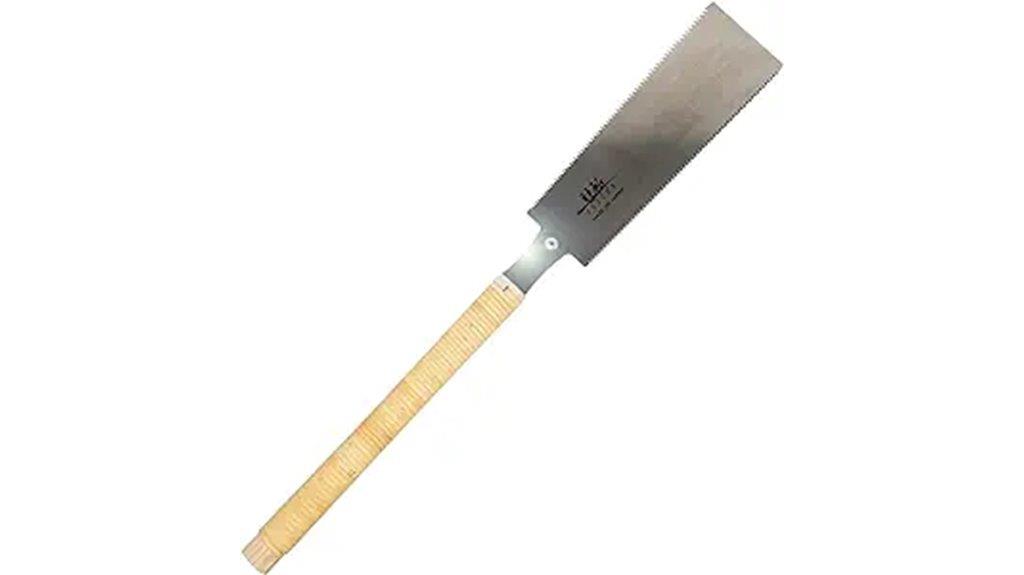
The SUIZAN Ryoba Double Edge Saw (9.5″) is an excellent choice for woodworkers who prioritize precision and ease of use. Its Japanese pull-stroke design makes cutting effortless, requiring less power and producing cleaner edges than push saws. The high-quality Japanese steel blade stays sharp longer and cuts smoothly through hardwoods like oak and maple. Crafted by master artisans in Japan, it combines traditional craftsmanship with practical functionality. The 9.5-inch blade is thin, flexible, and precise, while the wooden handle offers a comfortable grip. Overall, it’s a durable, versatile tool that enhances accuracy and reduces effort in any woodworking project.
Best For: woodworkers, DIY enthusiasts, and professionals seeking precise, clean cuts with minimal effort in various woodworking and carpentry projects.
Pros:
- Effortless pull-stroke design reduces strain and increases control during cutting.
- Razor-sharp Japanese steel blade maintains edge durability over time.
- Versatile for cutting hardwoods, softwoods, and non-wood materials with smooth, splinter-free results.
Cons:
- Hand-wrapped handle may vary in comfort; some users may want additional grip enhancements.
- Slight learning curve to adapt from push to pull cutting technique.
- Minor cracks or imperfections in the handle during manufacturing, though not defects.
Japanese Pull Saw, 9.5 Ryoba Hand Saw for Dovetails and Joinery
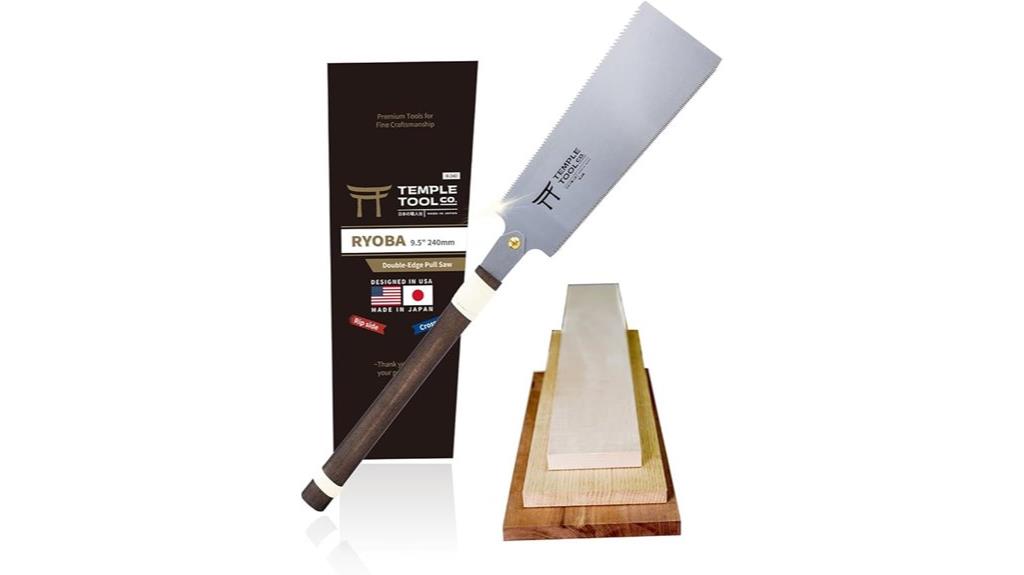
If you’re serious about achieving precise, clean cuts in woodworking, the Japanese Pull Saw—9.5 Ryoba Hand Saw by Temple Tool Co.—is an excellent choice. Its double-edge design offers rip teeth for cutting with the grain and crosscut teeth for across the grain, making it highly versatile for dovetails, joinery, and sizing. The lightweight, razor-sharp blade crafted from high-grade Japanese steel assures smooth, accurate cuts in both soft and hardwoods. Its handle, made from durable Wingnut wood with brass accents, provides a comfortable grip. With over a century of craftsmanship behind it, this saw delivers precision, ease of use, and durability for both professionals and enthusiasts.
Best For: woodworking enthusiasts and professionals seeking precise, versatile hand saws for joinery, dovetails, and general carpentry tasks.
Pros:
- Double-edge design with rip and crosscut teeth for versatile use
- Lightweight and ergonomically balanced for comfortable handling
- Crafted from high-quality Japanese steel ensuring long-lasting sharpness and smooth cuts
Cons:
- May require sharpening over extended heavy use
- Slightly higher price point compared to standard Western saws
- Not ideal for heavy-duty demolition or rough cuts
Japanese Pull Saw – 7 Ryoba Hand Saw with Rip-cut and Crosscut

For woodworkers who prioritize versatility and precision, the Japanese Pull Saw – 7 Ryoba Hand Saw with Rip-cut and Crosscut stands out as an excellent choice. Its double-edge design offers rip teeth for accurate cuts along the grain and crosscut teeth for smooth cuts across it, making it ideal for joinery, dovetails, and sizing. The compact 180mm blade provides better control and accuracy, especially for detailed work. Crafted with high-grade Japanese SK85 steel and a dark brown Wingnut wood handle, this saw combines durability, craftsmanship, and tradition. Made in Japan by skilled artisans, it’s a reliable tool that delivers clean, effortless cuts every time.
Best For: woodworkers seeking a versatile, precise, and durable saw for detailed joinery and stock sizing tasks.
Pros:
- Double-edge design with rip and crosscut teeth for enhanced versatility
- Compact 180mm blade offers superior control and accuracy
- Crafted from high-grade Japanese SK85 steel with a traditional Wingnut wood handle for durability and aesthetic appeal
Cons:
- May require some skill to switch between rip and crosscut sides effectively
- Slightly limited in cutting length due to the 180mm blade size
- As a traditional tool, it may need regular maintenance to retain optimal sharpness
SUIZAN Ryoba Double Edge Saw (8-inch) – Japanese Pullsaw for Woodworking

Ideal for both beginners and seasoned woodworkers, the SUIZAN Ryoba Double Edge Saw stands out with its dual-edged blade that easily handles rip and cross cuts. Its 8-inch blade, made from high-quality Japanese steel, ensures razor-sharp, clean cuts with minimal effort. The pull-cutting design makes woodworking smoother, lighter, and more precise compared to push saws. With a total length of 16.9 inches and a thin kerf of 0.03 inches, it’s perfect for detailed projects. Crafted in Japan by master artisans, this saw combines tradition, quality, and versatility—making it an essential tool for anyone aiming for craftsmanship and accuracy.
Best For: woodworking enthusiasts of all skill levels seeking precise, clean cuts with a traditional Japanese pull saw.
Pros:
- Sharp, high-quality Japanese steel blade ensures clean, accurate cuts
- Easier and lighter to use than push saws due to pull-cutting mechanism
- Versatile with dual-edged blade suitable for rip and cross cuts
Cons:
- May require a learning curve for those unfamiliar with pull saw techniques
- Blade thickness and kerf width might be limiting for very fine or delicate work
- Being a traditional Japanese tool, it may have a higher price point compared to some Western saws
RUITOOL Japanese Hand Saw for Woodworking
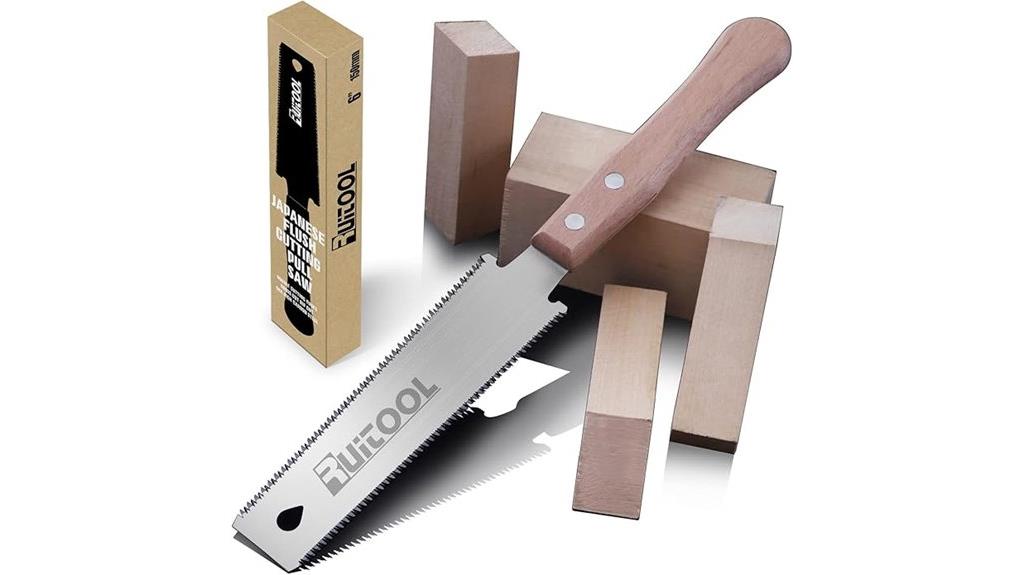
The RUITOOL Japanese Hand Saw for Woodworking stands out with its double-edged design, making it perfect for woodworkers who need versatility in their cuts. Its 6-inch SK5 high-carbon steel blade is both flexible and durable, ensuring long-lasting sharpness and resistance. One side with 17 TPI excels at cutting hardwood, while the other with 14 TPI handles softwood, supporting both rip and cross cuts. The three-sided grinding teeth provide smooth, fast cuts with less effort. Compact yet efficient, this saw is ideal for precise woodworking, carpentry, and craft projects, offering excellent performance and reliable after-sales support.
Best For: woodworking enthusiasts, carpenters, and craftsmen seeking precise, versatile hand saws for various cutting tasks.
Pros:
- Double-edged design with different TPI for hardwood and softwood cutting, enhancing versatility
- High-carbon SK5 steel blade with HRC60-63 hardness ensures long-lasting sharpness and durability
- Three-sided grinding teeth provide smooth, efficient cuts with less effort
Cons:
- 6-inch size may be less suitable for large-scale or heavy-duty cutting projects
- Requires manual effort, which might be tiring for extensive or repetitive cuts
- As a hand saw, it may not match the speed and power of powered cutting tools for certain tasks
SUIZAN Ryoba Double Edge Saw (9.5 inch)
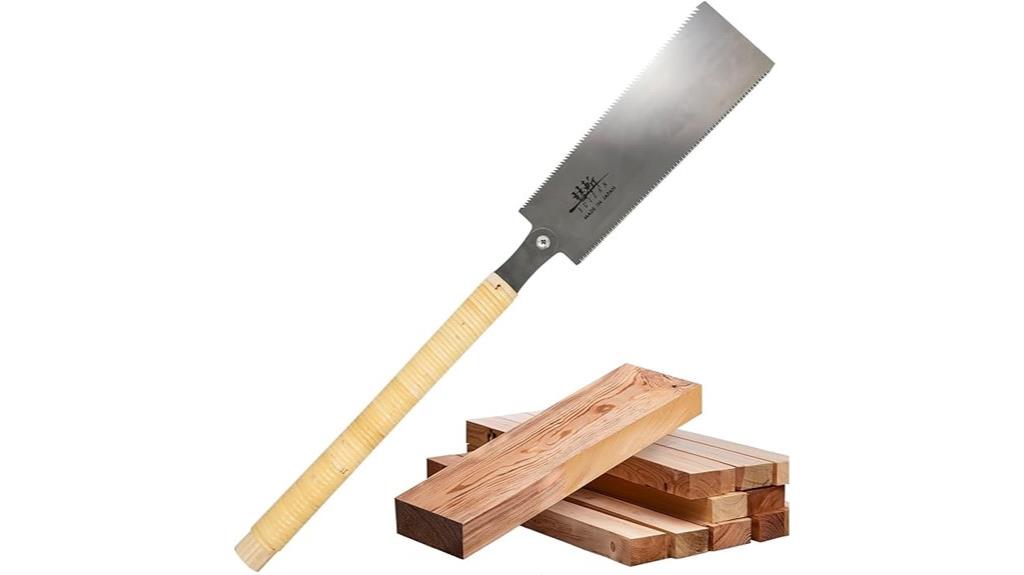
If you’re looking for a Japanese pull saw that combines traditional craftsmanship with reliable performance, the SUIZAN Ryoba Double Edge Saw (9.5 inch) stands out. Designed specifically for woodworking, it cuts via a pulling motion, which makes for lighter handling, less force, and cleaner edges. Made from high-quality Japanese steel, it offers razor-sharp precision. Crafted by master Japanese artisans with over 100 years of tradition, each saw is assembled domestically. With a 9.5-inch blade and a total length of 23.2 inches, it’s suitable for both beginners and pros, perfect for diversifying your woodworking projects with authentic Japanese technique.
Best For: both woodworking enthusiasts and professionals seeking a traditional Japanese pull saw for precise, clean cuts and versatile projects.
Pros:
- High-quality Japanese steel construction ensures razor-sharp, durable blades.
- Lighter weight and less force required due to pulling cutting motion, reducing fatigue.
- Suitable for a wide range of users, from beginners to seasoned craftsmen, with authentic Japanese craftsmanship.
Cons:
- Requires self-assembly, which may be challenging for some users.
- Variations in handle appearance due to hand wrapping; minor cracks during manufacturing are possible but not defects.
- Blade length and overall size may be less suitable for very large or heavy-duty cutting tasks.
Japanese Pull Saw, Dozuki 6 for Ripcut and Crosscut

For woodworkers seeking precise and versatile cuts, the Japanese Dozuki 6 pull saw stands out with its combination of rip and crosscut teeth, making it perfect for both rough and fine joinery. Its 25 TPI “Oni-Ba” teeth handle a variety of cuts, from rip to crosscut, while the compact 150mm blade offers excellent control. The thin, narrow-kerf design guarantees smooth, effortless pulls, suitable for all skill levels. Made with high-grade Japanese SK85 steel and durable brass fittings, it combines craftsmanship and functionality. Whether working on dovetails, tenons, or Kumiko, this saw delivers clean, accurate results every time.
Best For: woodworkers and hobbyists seeking precise, versatile cuts for both joinery and general woodworking tasks.
Pros:
- Combines rip and crosscut teeth with 25 TPI for versatile use
- Compact 150mm blade provides excellent control and accuracy
- Made with high-grade Japanese SK85 steel and durable brass fittings for long-lasting sharpness
Cons:
- May require some skill to optimize for fine joinery projects
- Narrow blade might be less suitable for very aggressive or rough cuts
- Limited blade length may not be ideal for larger cutting tasks
KERYE Japanese Pull Saw 9.5 Inch

With its 9.5-inch double-edged blade, the KERYE Japanese Pull Saw KY01 stands out as a versatile tool perfect for both detailed cross cuts and rough rip cuts. Its high carbon SK5 steel blade guarantees hardness, wear resistance, and longevity, while the ergonomic beechwood and rattan handle provides a comfortable grip. Weighing just 9.6 ounces, it’s lightweight and easy to control. The replaceable blades and 3-sided grinding teeth keep it sharp and durable. The bi-lateral design, featuring 10 TPI for rip cuts and 17 TPI for cross cuts, makes it ideal for a wide range of woodworking projects.
Best For: DIY enthusiasts, professional woodworkers, and hobbyists seeking a versatile, precise pull saw for various woodworking tasks.
Pros:
- High-quality SK5 steel blade offers excellent sharpness, durability, and wear resistance.
- Ergonomic beechwood and rattan handle provide comfortable, lightweight control during extended use.
- Replaceable blades and 3-sided grinding teeth ensure long-lasting sharpness and precise cuts.
Cons:
- Requires learning pull saw technique, which may take some adjustment for new users.
- Slight decline in blade sharpness may occur after extensive use, needing replacement over time.
- Not suitable for heavy-duty or demolition tasks; primarily designed for fine woodworking and trimming.
Japanese Pull Saw, 9.5″ Ryoba Hand Saw for Dovetails & Joinery

The Japanese Pull Saw, 9.5″ Ryoba Hand Saw by Temple Tool Co., stands out as an ideal choice for woodworkers seeking versatility and precision in their projects. Its double-edged design features rip teeth on one side for cutting along the grain and crosscut teeth on the other for across the grain, making it perfect for dovetails, joinery, and general tasks. Crafted from high-grade Japanese steel, it offers razor-sharp, clean cuts in both soft and hardwoods. The lightweight handle, made from durable Wingnut wood with brass accents, provides excellent grip and control. Its larger size and balanced design make it suitable for detailed work and timber framing alike.
Best For: woodworking enthusiasts and professionals seeking a versatile, precise hand saw for detailed joinery, furniture making, and general carpentry tasks.
Pros:
- Double-edged design with rip and crosscut teeth for versatile cutting options
- Razor-sharp Japanese steel blades provide clean, smooth cuts in various woods
- Lightweight, ergonomic handle offers excellent control and comfort during extended use
Cons:
- Larger size may require more space for maneuvering in tight or intricate cuts
- Handcrafted craftsmanship can lead to higher cost compared to mass-produced saws
- No electric or powered option, which may be less suitable for high-volume or rapid cutting needs
8 Inch Folding Hand Saw with Double Edges of 13/14 TPI
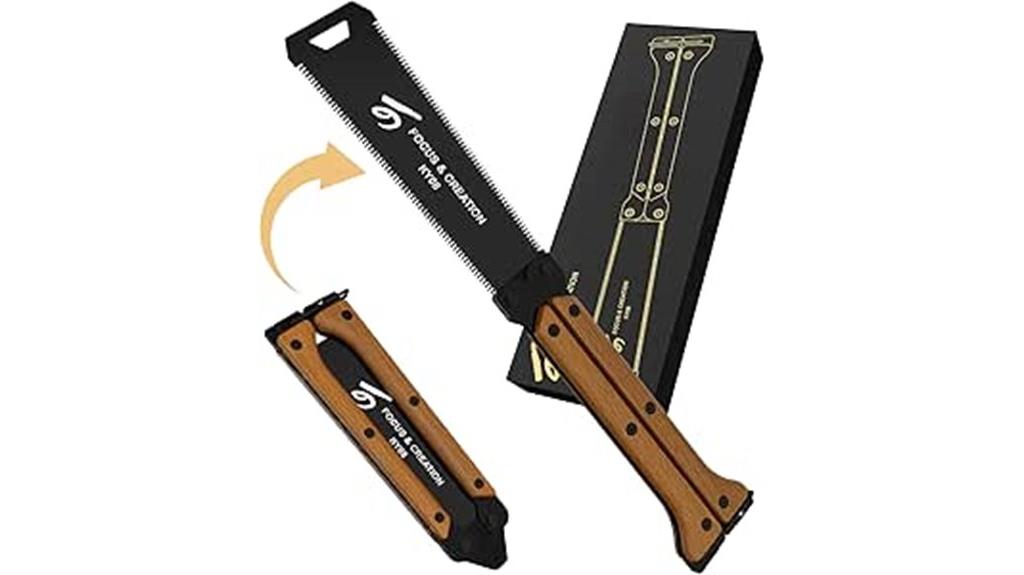
An 8-inch folding hand saw with double-edged teeth of 13 and 14 TPI offers versatile performance for those who need a compact, portable tool for precise cuts. Its SK5 steel blade is durable and flexible, with a triangular design that enhances stability. One side features 13 TPI for fine, detailed cuts in hardwoods, while the other with 14 TPI is perfect for rougher, cross cuts in softwoods. The ebony wood handle provides comfort and strength, and the foldable design guarantees safety and easy transportation. Ideal for outdoor use, camping, or light woodworking, this saw balances precision, portability, and quality.
Best For: outdoor enthusiasts, light DIYers, and professional woodworkers seeking a compact, precise folding saw for camping, light woodworking, or detailed cuts.
Pros:
- Durable SK5 steel blade with double-edged teeth for versatile cutting options
- Compact, foldable design with safety latch for portability and storage
- Elegant ebony wood handle providing comfort and a natural aesthetic
Cons:
- Slightly flexible blade may limit durability under heavy use
- Handle finish can be slippery, requiring additional sanding or oiling for better grip
- Black coating may wear over time, affecting appearance but not functionality
RUITOOL Japanese Hand Saw 6 Inch Double Edge Sided Pull Saw
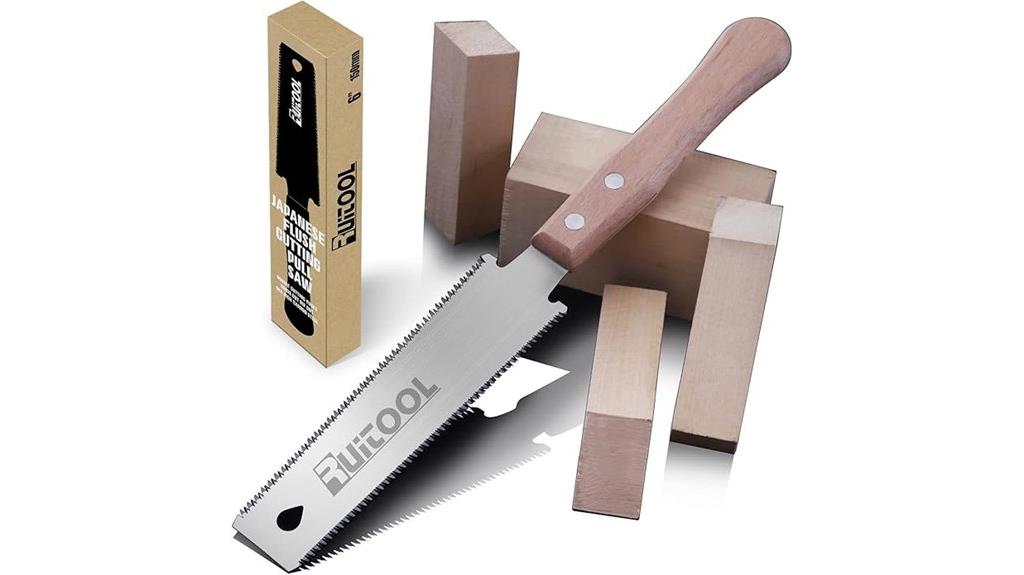
If you’re looking for a versatile saw that delivers precise cuts in both soft and hardwood, the RUITOOL Japanese Hand Saw 6 Inch Double Edge Sided Pull Saw is an excellent choice. Its flexible SK5 high-carbon steel blade, hardened to HRC60-63, guarantees long-lasting sharpness and durability. The double-edged design features 17 TPI for hardwood and 14 TPI for softwood, making it perfect for rip and cross cuts. The three-sided grinding teeth promote faster chip removal and smoother cuts, reducing fatigue during extended use. Compact and easy to handle, this saw is ideal for woodworking, carpentry, and craft projects, backed by reliable customer support.
Best For: woodworkers, carpenters, and craft enthusiasts seeking precise and versatile hand saws for soft and hardwood projects.
Pros:
- Durable SK5 high-carbon steel blade with HRC60-63 hardness for long-lasting sharpness.
- Double-edged design with 17 TPI for hardwood and 14 TPI for softwood, enhancing versatility.
- Three-sided grinding teeth for efficient chip removal and smooth cutting experience.
Cons:
- The 6-inch size may be less suitable for larger cutting tasks requiring longer blades.
- Requires proper maintenance to prevent rust and ensure optimal performance.
- May have a learning curve for users unfamiliar with pull saw techniques.
Co. Japanese Flush Cut Saw (6 Inch Double Edge Pull Saw)
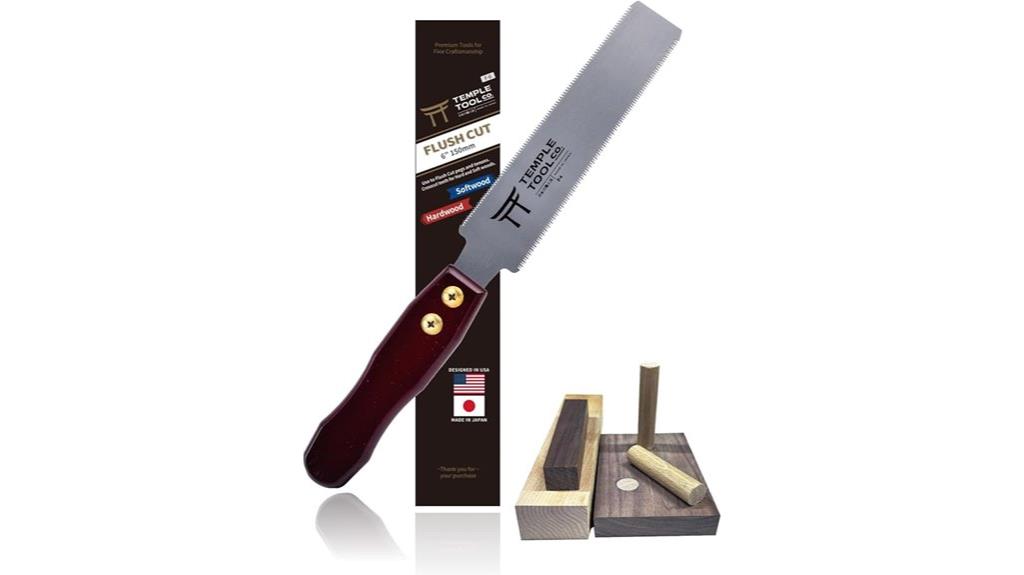
For woodworkers seeking flawless flush cuts, the Co. Japanese Flush Cut Saw (6 Inch Double Edge Pull Saw) is a standout choice. Designed specifically for trimming dowels, pegs, wedges, and tenons, it guarantees clean, professional finishes by cutting flush to surfaces. The dark brown Beach wood handle with brass accents offers durability and elegance, while the narrow-kerf blade cuts on the pull stroke for maximum precision. Crafted from high-grade Japanese steel, it stays sharp through tough cuts in both soft and hardwoods. Handcrafted in Japan by artisans with over a century of experience, this saw combines heritage craftsmanship with modern performance.
Best For: woodworkers and craftsmen seeking precise, flush cuts on dowels, pegs, wedges, and trim pieces for a professional finish.
Pros:
- Combines Japanese craftsmanship with modern design for durability and precision
- Narrow-kerf blade cuts smoothly on the pull stroke, ensuring clean, accurate cuts
- High-grade Japanese steel maintains sharpness through tough materials and frequent use
Cons:
- Handcrafted in Japan may lead to higher cost compared to mass-produced alternatives
- Requires proper technique to maximize the benefits of the pull-cutting action
- The small size (6 inch blade) may not be suitable for heavy-duty or larger-scale projects
Japanese Pull Saw (Dozuki 6″) for Ripcut and Crosscut
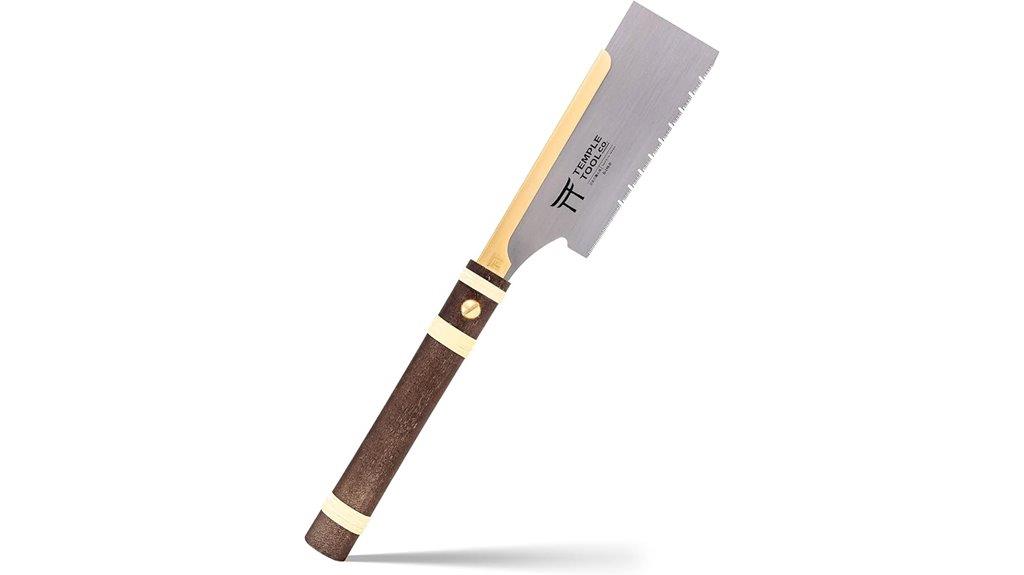
The Japanese Dozuki 6″ pull saw stands out as an excellent choice for woodworkers seeking precision and versatility, thanks to its unique combination of crosscut and rip-teeth in a single blade. Its 25 TPI teeth, called “Oni-Ba” or “Demon-Teeth,” allow for clean, accurate cuts in both directions. The compact 150mm size provides excellent control, making detailed work easier. Crafted from high-grade Japanese SK85 steel, it stays sharp longer, while the brass back and dark wood handle add durability and style. Perfect for softwoods and hardwoods, this saw offers effortless, precise cuts—ideal for professional carpentry or hobbyist projects.
Best For: professional woodworkers and hobbyists seeking precise, versatile cuts in both softwoods and hardwoods with a high-quality, durable pull saw.
Pros:
- Combines crosscut and rip-teeth (“Oni-Ba”) for versatile use in one blade
- Crafted from high-grade Japanese SK85 steel for long-lasting sharpness
- Compact 150mm size offers excellent control for detailed work
Cons:
- May require some skill to master the pull-stroke technique effectively
- Slightly higher price point due to craftsmanship and materials
- Limited blade length might not be suitable for very large cuts
Co. Japanese Pull Saw, Crosscut 9.5-inch Hand Saw for Joinery
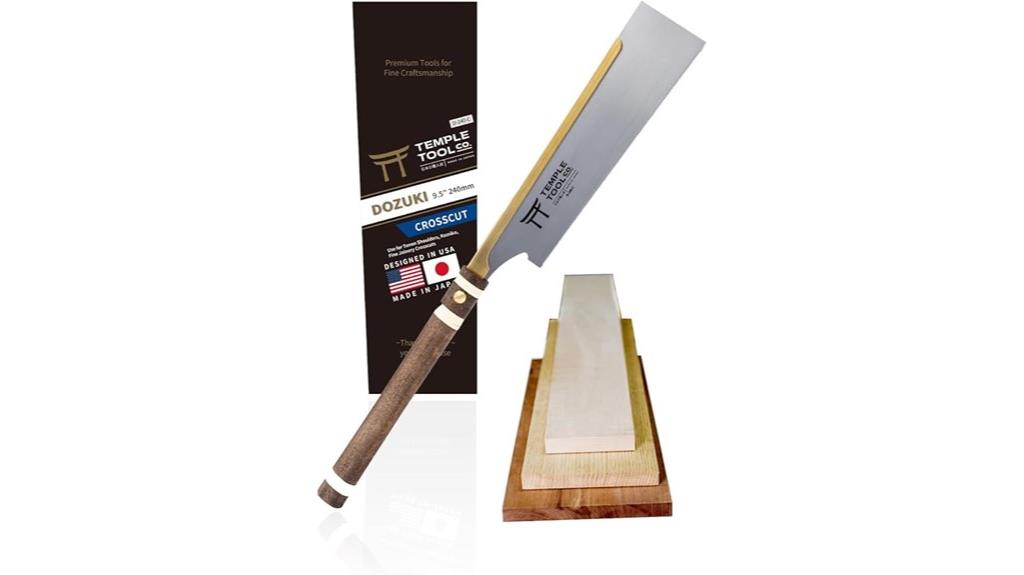
Crafted in Japan by skilled artisans, the Co. Japanese Pull Saw, Crosscut 9.5-inch Hand Saw for Joinery offers precision and ease for detailed woodworking. With 25 TPI crosscut teeth, it effortlessly cuts soft and hardwoods, producing clean, accurate results. The handcrafted blade, made from high-grade Japanese steel, stays sharp through repeated use. Its ergonomic handle, crafted from dark walnut-like Wingnut wood with brass accents, provides comfortable control. The thin kerf and pull stroke design make for smooth, precise cuts with minimal effort. Lightweight and well-balanced, this saw is ideal for joinery, Kumiko, and delicate projects—perfect for both beginners and professionals.
Best For: woodworking enthusiasts and professionals seeking precise, delicate cuts in soft and hardwoods with a handcrafted Japanese pull saw.
Pros:
- Razor-sharp 25 TPI teeth for clean, accurate cuts in various woods
- Handcrafted with high-quality Japanese steel ensuring long-lasting sharpness
- Ergonomic handle and lightweight design for comfort and control
Cons:
- Slightly higher price point compared to mass-produced saws
- Requires proper technique to maximize the pull stroke cutting method
- Limited blade length may be less suitable for very large cut projects
SUIZAN Flush Cut Saw 5 – Professional Japanese Pullsaw

If you’re seeking a professional-grade saw that offers clean, precise cuts in woodworking projects, the SUIZAN Flush Cut Saw 5-inch pullsaw is an excellent choice. Its Japanese pull-cut mechanism delivers smoother edges than European push saws, making it ideal for fine detail work. Made in Japan by master craftsmen, it features a razor-sharp, high-quality steel blade with 25 teeth and a thin kerf for minimal tear-out. Lightweight and ergonomic, it’s easy to handle and perfect for trimming, inlays, and delicate cuts on hardwoods or softwoods. Many users praise its precision, durability, and value, making it a versatile tool for professionals and DIY enthusiasts alike.
Best For: DIY enthusiasts and professional woodworkers seeking precise, clean cuts in detailed woodworking projects and trim work.
Pros:
- Extremely sharp, delivering smooth, clean edges with minimal effort
- Compact and lightweight design for easy handling and portability
- Double-edged blade optimized for both hardwoods and softwoods, enhancing versatility
Cons:
- Blade is non-replaceable, requiring careful maintenance to prevent rust
- Handles may vary in durability over time with extended use
- Requires proper technique and practice to master the pull-cut method effectively
Factors to Consider When Choosing a Japanese Pull Saw

When choosing a Japanese pull saw, I consider factors like blade size, teeth per inch, and blade material to guarantee it fits my project needs. Comfort and grip are also vital for precise cuts, especially during long tasks. Finally, I look at versatility to find a saw that performs well across different materials and projects.
Blade Size and Length
Choosing the right blade size and length is essential for getting the best results with a Japanese pull saw. A smaller blade offers greater precision, making it ideal for intricate cuts and detailed work. Larger blades provide more cutting capacity and are better suited for thicker materials or larger projects. The overall length of the saw impacts leverage and handling; longer blades allow for deeper cuts and efficiency on bigger surfaces, while shorter blades excel in tight spaces and delicate tasks. Common sizes range from about 5 inches for fine work to over 10 inches for larger cuts. Matching the blade size to your project ensures better control, safety, and efficiency. Proper selection helps you balance maneuverability with cutting depth, making your woodworking smoother and more accurate.
Teeth Per Inch
Teeth per inch (TPI) plays a crucial role in how a Japanese pull saw performs, directly impacting cutting speed and finish quality. A higher TPI, like 17-25, produces finer, smoother cuts perfect for detailed work and finishing touches. Conversely, lower TPI, around 9-14, allows for faster, more aggressive cuts, ideal for roughing out material or cutting hardwood. The TPI also affects the kerf width; more teeth per inch create a narrower kerf, which enhances precision. When choosing a saw, matching the TPI to your project is necessary—finer teeth for delicate, precise cuts, and coarser teeth for quick, rough cuts. This balance ensures you get peak performance, minimizing tear-out and splintering while achieving the desired finish.
Blade Material Quality
High-quality Japanese pull saw blades are crafted from specialized steels like SK5 or SK85, which give them exceptional hardness and durability. These steels are often hardened through high-frequency processes, ensuring the blades stay sharp longer and resist wear. Sharp blades with fine teeth, typically 15-25 TPI, allow for smooth, clean cuts with minimal tearing or splintering. The thin kerf design, around 0.02 to 0.03 inches, reduces material waste and requires less effort during cutting. Additionally, premium blades made from high-grade steel are resistant to rust and corrosion, especially when treated or coated. This durability not only prolongs the lifespan of the saw but also maintains ideal cutting performance over time. Blade material quality is vital for precise, effortless results.
Handle Comfort and Grip
A comfortable handle makes a big difference in how easily and accurately you can use a Japanese pull saw. It should fit well in your hand, reducing fatigue during prolonged use. Ergonomic grips often feature textured or contoured surfaces, which prevent slipping and give you better control. Handles made from natural wood or rubberized materials can offer improved grip and cushioning, making cuts smoother and less tiring. The size of the handle is also essential—it should match your hand size to allow a secure grip without causing strain. A well-designed handle minimizes hand fatigue and enhances precision, especially when making delicate or detailed cuts. Prioritizing comfort and grip ensures you work more efficiently and enjoy a better overall sawing experience.
Versatility for Projects
When choosing a Japanese pull saw, considering its versatility is key to ensuring it can handle a variety of woodworking projects. A versatile saw often features a double-edged blade with rip teeth on one side and crosscut teeth on the other, allowing it to tackle both rip cuts and crosscuts efficiently. Its thin kerf and fine teeth, usually between 9 to 17 TPI, enable precise, clean cuts across different wood types, from softwoods to hardwoods. The pull stroke design reduces effort and minimizes waste, making it suitable for delicate joinery and rough cuts alike. Additionally, adjustable or replaceable blades let you switch between configurations for specific tasks. This multi-purpose capability makes a Japanese pull saw an essential tool for dovetailing, trimming, sizing, and detailed finish work.
Blade Replacement Options
Choosing a Japanese pull saw with replaceable blades can considerably extend its usefulness and keep it performing at its best. When selecting one, I check if the blades are compatible with standard sizes or specific models, making replacements easier and guaranteeing availability. A secure locking mechanism or attachment system is essential to prevent accidents and guarantee precise cuts. I also consider if the replacement blades are cost-effective and readily available through the manufacturer or third-party suppliers. Additionally, I look for saws designed for quick, tool-free blade changes, which saves time during ongoing projects. These features help maintain performance, reduce downtime, and make the tool more versatile for various tasks. Ultimately, choosing the right blade replacement options ensures consistent, effortless cuts and maximizes the saw’s lifespan.
Frequently Asked Questions
What Are the Main Differences Between Ryoba and Dozuki Saws?
You’re wondering about the differences between ryoba and dozuki saws. I find that ryoba saws are versatile, with teeth on both sides for cross-cutting and rip-cutting, making them great for general woodworking. Dozuki saws, on the other hand, have a thin, rigid blade with set teeth, perfect for precise, fine cuts and joinery. I prefer dozuki for detailed work, while ryoba handles broader tasks efficiently.
How Do I Maintain and Sharpen Japanese Pull Saws?
Maintaining and sharpening Japanese pull saws can be a satisfying routine. I gently clean the blade after each use, avoiding harsh chemicals, and keep it dry to prevent rust. For sharpening, I use a fine file or sharpening stone, gently honing the teeth along the bevel. Regular care keeps the saw cutting smoothly, making every project feel like a breeze. Trust me, a well-maintained saw makes your work truly enjoyable.
Which Japanese Pull Saw Is Best for Hardwood Versus Softwood?
When choosing a Japanese pull saw, I consider the material I’ll be cutting. For hardwood, I prefer a saw with thicker, stronger teeth like the Ryoba or Dozuki, which handle dense wood with precision. For softwood, I opt for a thinner, finer-toothed saw such as a Kataba, making effortless, clean cuts. Matching the saw to the wood type guarantees better control and results, saving time and effort.
Are Japanese Pull Saws Suitable for Beginner Woodworkers?
I believe Japanese pull saws are great for beginners. I once recommended a beginner friend who struggled with traditional saws; she switched to a Japanese pull saw, and her cuts became cleaner and easier. These saws are user-friendly because they cut on the pull stroke, giving more control. So, if you’re starting out, a Japanese pull saw can boost your confidence and improve your woodworking skills quickly.
How Does the Tooth Pitch Affect Cutting Performance?
Understanding how tooth pitch affects cutting performance is pretty important. I’ve found that a finer tooth pitch, with more teeth per inch, gives me cleaner, smoother cuts, especially on delicate or detailed work. Conversely, a coarser pitch cuts faster and is better for rough or thicker materials. So, choosing the right tooth pitch depends on whether I need precision or speed, and I always match it to the task at hand.
Conclusion
After exploring these top Japanese pull saws, I’m amazed by their precision—did you know that some can cut with a tolerance of just 0.1mm? Whether you’re into detailed joinery or quick, clean cuts, these tools make woodworking easier and more accurate. Choosing the right saw can transform your projects, making them feel almost effortless. Trust me, investing in one of these will elevate your craftsmanship to a whole new level.
